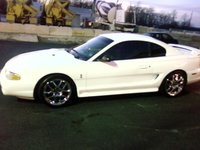why do injectors support more crank hp on a n/a engine over a forced induction engine?
i have a cobra with a vortech blower on it. i just swapped from 42lb injectors to 60lb because im upgrading my blower and i was considering switching to a turbo to avoid parasitic loss thats associated with superchargers. i was doing research and i was on modularmustangracing.com and under their fuel components link was a graph showing what injector size supported each crank horsepower levels between n/a, supercharger, and turbo'd. if you get more hp per pound of boost with a turbo, why would the same size injector on a turbo support less than a supercharger? and one more thing, anyone like supporting the stock "sleeper" look?
2 Answers
When it comes to fuel injectors and gasoline spark ignition engines, there is a simple rule of thumb to go by. In order for an engine to produce power it needs a certain mix of air and fuel. The ideal mix is called a Stoichiometric air/fuel ratio, which is about 14.7:1 air to fuel. At that air/fuel there is exactly enough oxygen to burn the amount of fuel that is present with no leftover fuel or oxygen. Now, when tuning a set of injectors for a high power performance application, there are a few other factors that have to be taken into consideration. Compressing air causes a significant increase in air temperature. The higher the boost pressure, the more heat is added to the fresh air due to the inefficiency of a turbo or supercharger (most turbines have a maximum efficiency of about 75-80% in their sweet spots). This is why trying to run more boost with a small turbo will just end adding heat to the charge as efficiency drops of severly outside the sweet spot of the compressor map. What is the bad part about heat in the fresh air? First the heat means the air is less dense. And less dense means that there is less oxygen in a given volume. So we implement things like intercoolers to cool the charge, and increase the density thereby squeezing more oxygen into the same volume. Secondly the hotter the fresh mix, the more likely that the charge will detonate too early during the compression stroke. This event is known as preignition and can be very damaging to the motor. How does all this relate to fuel injection? In order to cool the charge tuners often flow a significant excess of fuel than what stoichiometric requires. On high boost turbos its not uncommon to see A/F ratios as rich as 11:1. All this extra fuel evaporates in the heat and in the process of changing from liquid to gas (remember your grade school science class) it will absorb the heat around it and cool the charge, thus reducing the risk of preignition. So when it comes to injector sizing, one has to consider the efficiency of the compressor (be it supercharger or turbocharger) the more efficient it is the cooler the compressed air will be and the less charge cooling (extra fuel) will be required. A less efficient compressor, the more heat will be introduced into the charge and the more charge cooling (extra fuel) will be required just to minimize the risk of preignition/detonation. On a naturally aspirated engine, there is no such compression of the intake air, heated fresh charge is less of an issue. As a result it is often the case that not quite as much extra fueling is required to increase power. After all, out of the fuel injected only the amount that has oxygen to react with will actually burn and create power (stoichiometric). The rest of the fuel that is there (rich) does NOT burn (lack of oxygen!) and thus does not add power, it simply enables a cooler charge. To make peak power with a NA motor, the A/F is usually slightly rich of stoichiometric. in the 13.5 range is approximate. Not counting the effects of charge cooling (which are still beneficial for NA engines) there is a chemical process called dissociation that occurs near stoichiometric at high temperatures of combustion. I apologize if I'm getting too technical, but a simple way of explaining it is that in nature, the combustion is never perfect even with exactly the right amount of fuel and air there will be a bit of oxygen and fuel left after combustion, so we put a bit of extra fuel in there, just to force the combustion of that last bit of oxygen. wow that's a long post. Can you tell that I'm an engineer who calibrates engines for a living? lol O yes, I'm a big fan of the sleeper look :-) I daily drive a 500hp Evo 8 that has been debaged and de-winged to look like a regular sedan. Walk softly and carry a big stick.
wow and thanks, i followed that as best i could, and im pretty sure i get it. i love the sleeper idea, its great spanking cars that cost 3x more than the one you're driving.
